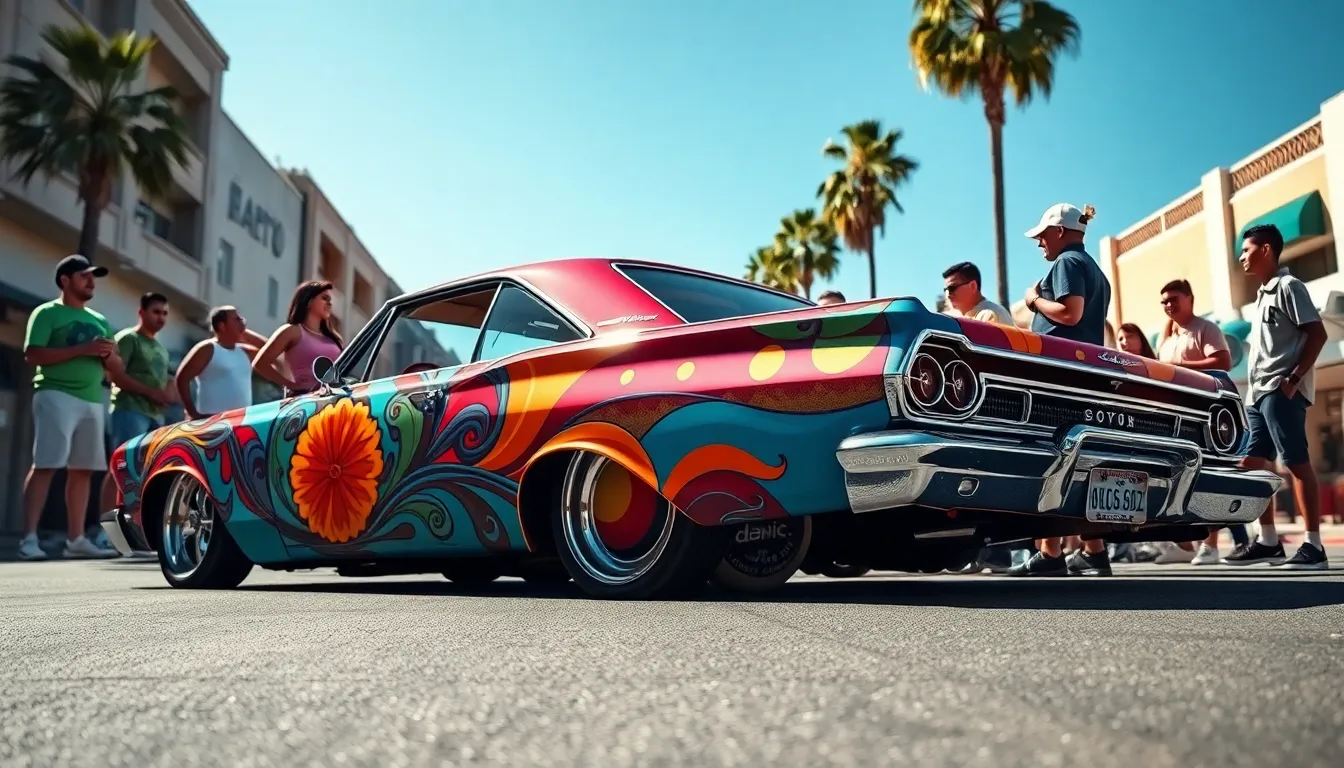We’ve all seen them cruising down the street with their distinctive bouncing motion and chrome-plated perfection – lowrider cars represent one of America’s most iconic automotive subcultures. These meticulously crafted machines aren’t just vehicles; they’re rolling works of art that tell stories of cultural pride creativity and mechanical ingenuity.
Born from the Chicano communities of California in the 1940s lowriders have evolved into a global phenomenon that celebrates both style and substance. From their hydraulic suspension systems that create that signature hop to their elaborate paint jobs and custom interiors every element serves a purpose in this automotive art form.
Whether you’re fascinated by the engineering behind those gravity-defying hydraulics or drawn to the rich cultural history these cars represent we’re diving deep into everything that makes lowriders so captivating. Join us as we explore the craftsmanship passion and community that drive this remarkable car culture forward.
What Are Low Riders Cars and Their Cultural Significance
Lowrider cars represent far more than modified vehicles—they embody a rich cultural movement born from resilience and artistic vision. We explore how these distinctive automobiles became symbols of identity and community pride throughout generations.
Origins in Chicano Culture
Chicano communities in 1940s California created the lowrider movement as a form of cultural resistance and self-expression. Mexican American youth faced discrimination and sought ways to assert their identity through automotive customization. They transformed ordinary cars into rolling works of art that challenged mainstream automotive culture.
Post-Industry War II economic growth allowed young Chicanos to purchase affordable used vehicles and modify them extensively. East Los Angeles became the epicenter of this emerging subculture during the 1950s. Customizers developed techniques to lower their cars using cut springs and sandbags before hydraulic systems emerged.
Civil rights tensions of the 1960s further solidified lowriders as symbols of Chicano pride and unity. Car clubs formed tight-knit communities that preserved Mexican American traditions while creating new forms of artistic expression. Families passed down customization knowledge through generations, establishing lowriding as a cultural heritage practice.
Artistic Expression Through Automotive Modification
Lowrider artists transform vehicles into mobile canvases that showcase incredible craftsmanship and cultural storytelling. Intricate murals depicting religious imagery, family portraits, and historical scenes cover every surface of these automotive masterpieces. Chrome accessories, custom upholstery, and detailed pinstriping demonstrate the owner’s dedication to perfection.
Hydraulic suspension systems allow cars to “dance” by raising and lowering at the push of a button. Customizers install multiple pumps, batteries, and switches to create complex choreographed movements. Competition events showcase these mechanical marvels performing synchronized routines that captivate audiences worldwide.
Interior modifications feature luxurious materials like crushed velvet, hand-stitched leather, and gold-plated accents. Sound systems with powerful amplifiers and subwoofers turn lowriders into mobile entertainment centers. Every modification reflects the owner’s personality while honoring the cultural traditions that inspired this art form.
Essential Components That Define Low Riders Cars
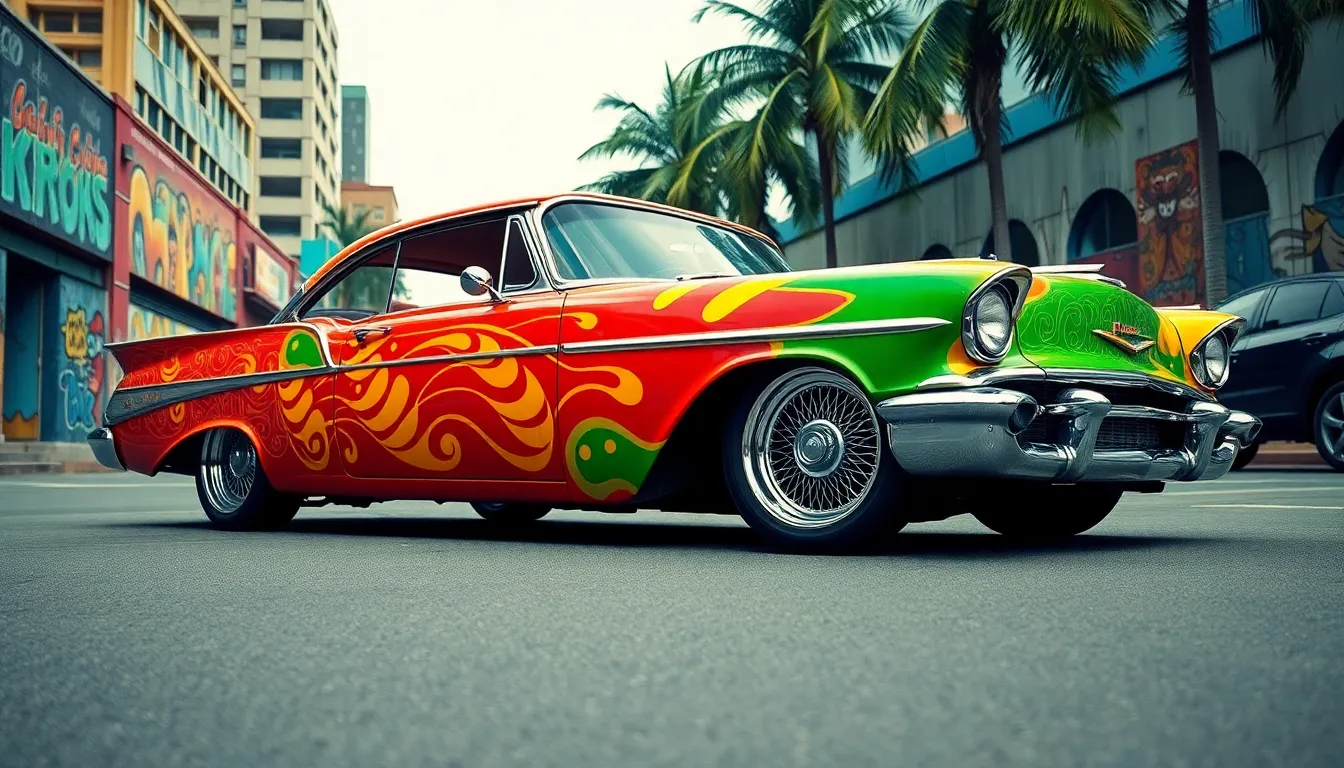
We’ve explored the cultural significance of lowriders, but understanding their signature components reveals why these vehicles captivate car enthusiasts worldwide. Three essential elements transform ordinary automobiles into the distinctive lowrider masterpieces that roll through neighborhoods as moving art galleries.
Hydraulic Suspension Systems
Hydraulic suspension systems serve as the beating heart of every authentic lowrider car. We recognize these complex mechanical marvels for their ability to raise and lower vehicles on command, creating the famous “dancing” effect that defines lowrider culture. Most systems use aircraft grade hydraulic pumps that deliver fluid pressure ranging from 1,500 to 3,000 PSI through steel lines to custom built cylinders.
Advanced setups feature independent control for each wheel, allowing skilled drivers to perform three wheel motion, side to side rocking, and front to back bouncing patterns. Competition grade hydraulic systems can lift a car’s front end over 60 inches off the ground while maintaining precise control throughout the movement. Battery banks consisting of multiple deep cycle batteries power these systems, with serious enthusiasts running 8 to 16 batteries to ensure consistent performance during extended hop competitions.
Wire Spoke Wheels and Whitewall Tires
Wire spoke wheels represent the quintessential lowrider aesthetic that distinguishes these vehicles from other custom car styles. We typically see 13 inch and 14 inch wire wheels adorning classic lowriders, with 72 spoke configurations being the most popular choice among purists. Premium wire wheels feature chrome plated spokes, gold accents, and intricate engraving patterns that reflect light beautifully under streetlights and car show spotlights.
Whitewall tires complete the classic lowrider look by providing stark contrast against dark pavement and colorful paint schemes. Tire manufacturers like Coker and Diamond Back produce authentic whitewall tires specifically for the lowrider market, with widths ranging from narrow 1 inch bands to bold 4 inch white sidewalls. Many enthusiasts choose 175/70R13 and 185/70R14 tire sizes to maintain the proper stance while ensuring adequate ground clearance during normal driving.
Custom Paint Jobs and Murals
Custom paint jobs transform lowrider exteriors into rolling canvases that showcase artistic talent and cultural storytelling. We observe paint schemes ranging from simple two tone combinations to elaborate murals featuring religious imagery, cultural symbols, and family portraits. Candy paint finishes remain extremely popular, using translucent colors over metallic base coats to create depth and brilliance that shifts in different lighting conditions.
Airbrushed murals often cover entire hood surfaces, trunk lids, and side panels with scenes depicting Aztec warriors, beautiful women, or neighborhood landmarks. Professional lowrider painters like Art Himsl and Big Sleeps have elevated automotive artistry to gallery worthy levels, with their work commanding thousands of dollars per vehicle. Clear coat applications protect these masterpieces, with some builders applying 15 to 20 coats to achieve mirror like finishes that enhance every painted detail.
Most Popular Low Riders Cars Models Throughout History
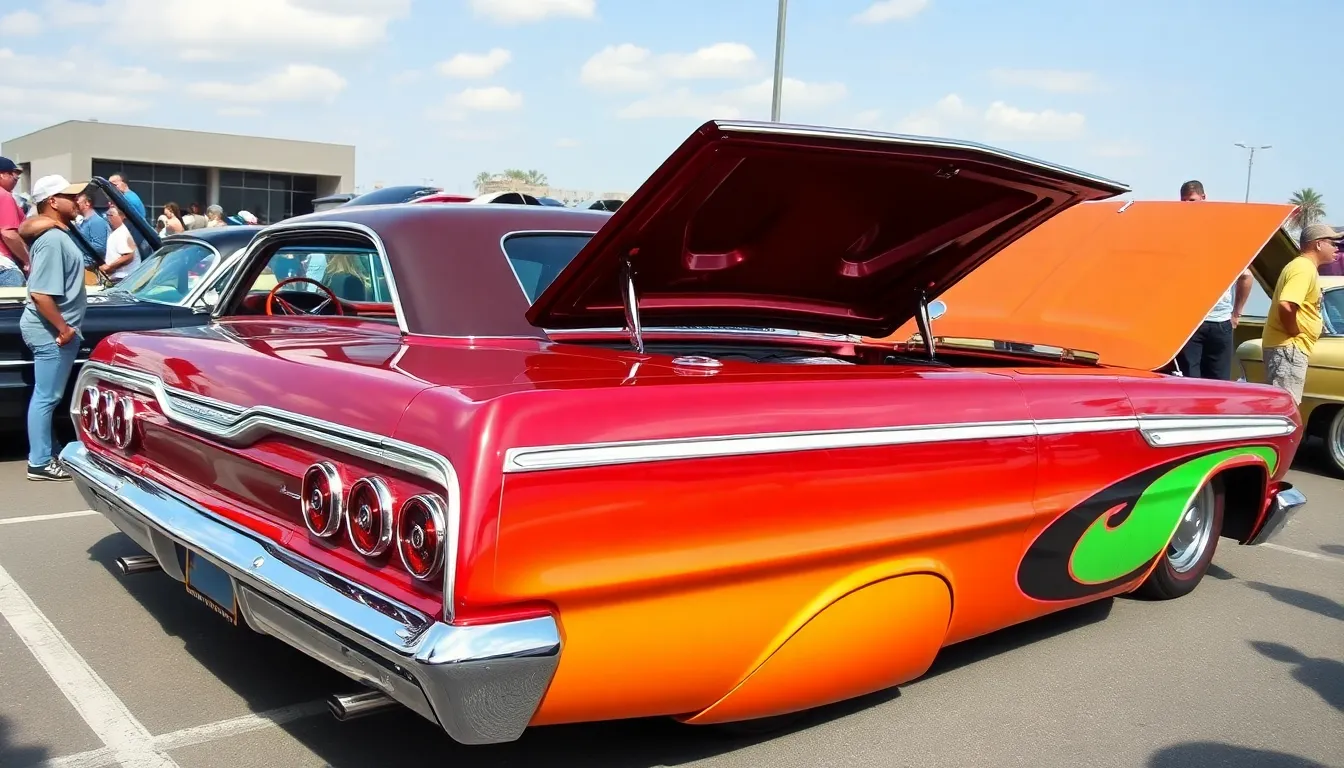
Certain automotive models have achieved legendary status within lowrider culture, earning their place through perfect proportions, modification potential, and cultural significance. We’ll explore the most iconic vehicles that defined generations of lowrider enthusiasts.
1964 Chevrolet Impala
The 1964 Chevrolet Impala stands as the undisputed king of lowrider cars, representing the pinnacle of automotive artistry within Chicano culture. This model year features the ideal combination of sleek lines, spacious interior, and robust frame construction that makes it perfect for hydraulic modifications.
Lowrider builders prize the ’64 Impala for its distinctive angular roofline and panoramic rear window that creates an unmistakable silhouette. The car’s long wheelbase provides excellent stability when equipped with hydraulic systems, while its wide stance accommodates the elaborate wire wheel setups that define classic lowrider aesthetics.
Custom shops frequently choose this model because of its extensive aftermarket support and proven modification potential. The Impala’s unibody construction handles the stress of hydraulic dancing better than many other vehicles, making it a reliable canvas for extreme customization projects.
Cultural significance elevates the 1964 Impala beyond mere transportation, as it appears in countless lowrider magazines, music videos, and cultural celebrations. Many families pass down these vehicles through generations, creating automotive heirlooms that preserve both mechanical craftsmanship and cultural memory.
Cadillac DeVille and Fleetwood
Cadillac DeVille and Fleetwood models represent the luxury segment of lowrider culture, offering premium materials and sophisticated styling that appeal to builders seeking elegance over pure customization potential. These full size sedans from the 1970s and 1980s provide the substantial presence that commands respect at lowrider gatherings.
DeVille models feature plush interiors with genuine leather seating and wood grain trim that serves as an excellent foundation for custom upholstery work. The cars’ naturally smooth ride quality complements hydraulic modifications, creating vehicles that combine comfort with show stopping performance.
Fleetwood variants offer even more spacious accommodations with extended wheelbases that showcase elaborate paint schemes and murals effectively. These models typically feature more chrome trim and luxury appointments, reducing the need for extensive exterior modifications while maintaining authentic lowrider appeal.
Engine options in these Cadillacs include powerful V8 motors that provide adequate power for hydraulic pumps and accessories without compromising reliability. Many builders appreciate the cars’ factory electrical systems that can handle additional components like advanced sound systems and lighting modifications.
Ford LTD and Mercury Grand Marquis
Ford LTD and Mercury Grand Marquis models gained popularity among lowrider enthusiasts during the 1980s and 1990s as affordable alternatives to traditional Chevrolet and Cadillac platforms. These full size sedans offer generous proportions and sturdy construction that accommodates hydraulic systems effectively.
LTD models from the mid 1980s feature boxy styling that provides large surface areas for custom paint work and murals. The cars’ substantial weight helps maintain stability during hydraulic demonstrations, while their spacious interiors accommodate elaborate sound system installations.
Mercury Grand Marquis vehicles share similar characteristics with additional luxury touches that appeal to builders seeking premium features at reasonable prices. These models often include power accessories and climate control systems that integrate well with custom modifications.
Parts availability remains excellent for both platforms, making maintenance and restoration more affordable than rare or exotic vehicles. Many lowrider clubs embrace these models as practical choices that deliver authentic lowrider experiences without the premium costs associated with classic Impalas or luxury Cadillacs.
Hydraulic Systems That Make Low Riders Cars Bounce
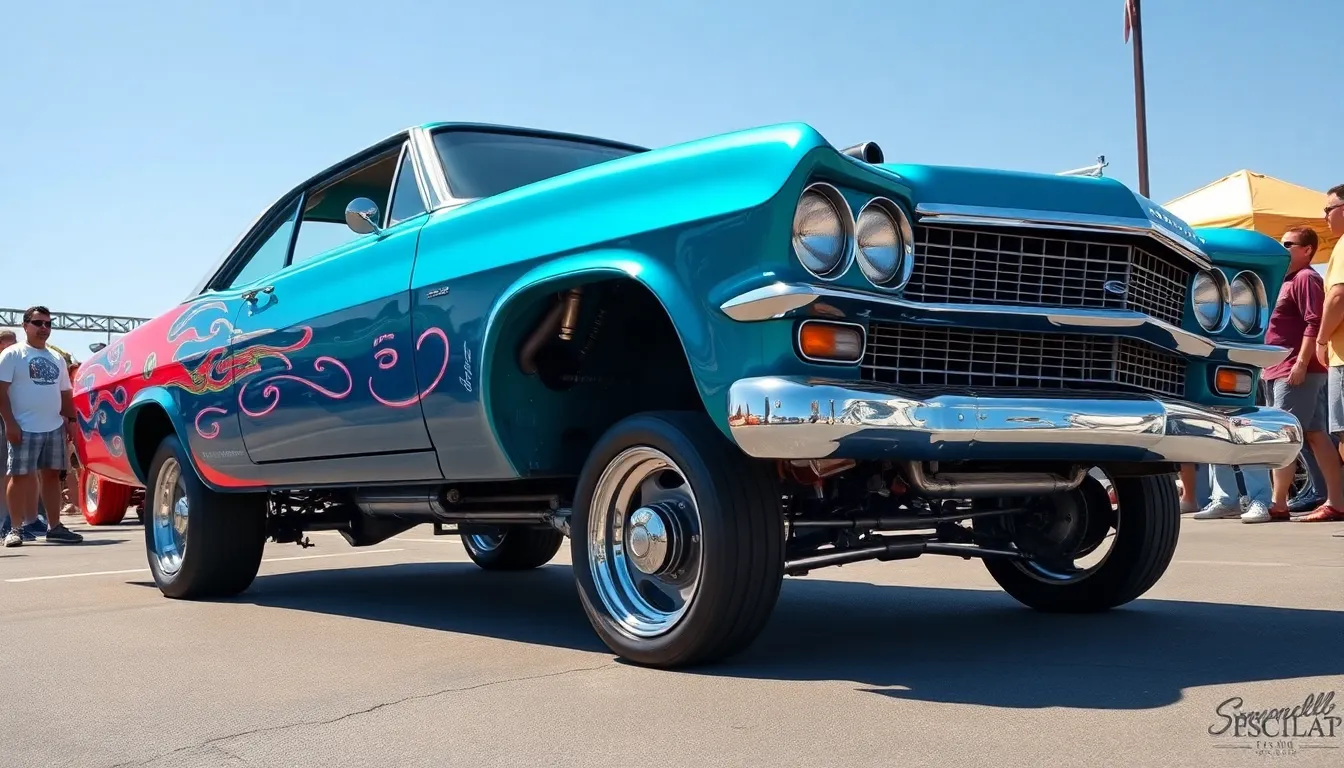
Hydraulic systems transform ordinary suspension components into engineering marvels that allow lowriders to perform their signature bouncing movements. These sophisticated setups use pressurized fluid to rapidly raise and lower each wheel independently, creating the mesmerizing dance that defines lowrider culture.
Single Pump Setups for Beginners
Starting with a single pump configuration offers newcomers an affordable entry point into hydraulic systems. Basic setups typically cost between $800 to $1,500 and provide enough lift to achieve the classic lowrider stance. We recommend installing 8-inch or 10-inch cylinders for front suspension modifications, as these sizes deliver reliable performance without overwhelming complexity.
Most single pump systems operate at 1,000 to 1,500 PSI pressure levels, generating sufficient force to lift the front end 12 to 18 inches off the ground. Beginners often choose this setup because installation requires fewer modifications to the vehicle’s frame and electrical system. Simple control switches mounted on the dashboard allow drivers to operate the hydraulics with minimal learning curve.
Entry level enthusiasts frequently select Adex or Pro Hopper single pump kits for their first hydraulic installation. These manufacturers provide comprehensive packages that include pumps, tanks, cylinders, and necessary hardware for complete installation. Quality single pump setups typically feature 2-gallon hydraulic fluid reservoirs and require only basic 12-volt electrical connections.
Multi-Pump Configurations for Advanced Hopping
Advanced hopping competitions demand multi-pump hydraulic systems capable of launching vehicles several feet into the air. Competition grade setups often feature 4 to 6 individual pumps, with each pump dedicated to exact wheel movements for maximum control precision. We’ve observed winning hoppers achieve vertical lifts exceeding 60 inches using these sophisticated configurations.
Professional hopping vehicles use 14-inch stroke cylinders paired with high-pressure pumps operating at 2,500 to 3,000 PSI. These systems require extensive frame reinforcement including aircraft-grade steel plates welded throughout the chassis structure. Competition hoppers typically weigh 500 to 800 pounds more than stock vehicles due to hydraulic components and reinforcement materials.
Elite hopping setups incorporate computer-controlled solenoid valves that enable split-second timing adjustments during competitions. Advanced configurations feature individual accumulators for each cylinder, storing pressurized fluid for rapid deployment during hopping sequences. Top competitors invest $15,000 to $25,000 in their hydraulic systems, including custom-machined components and specialized racing oils.
Battery Requirements and Electrical Systems
Hydraulic systems demand substantial electrical power to operate pumps and solenoid valves effectively throughout extended use periods. Most single pump setups require minimum 4 deep-cycle marine batteries providing 800 to 1,000 cold cranking amps total capacity. We recommend Group 31 batteries for their balance of power output and physical size constraints within vehicle installations.
Competition hopping vehicles typically install 8 to 12 batteries arranged in series and parallel configurations to meet extreme power demands. These setups often require custom battery boxes fabricated from aluminum or steel, positioned strategically for optimal weight distribution. Advanced electrical systems feature 200-amp alternators and voltage regulators to maintain consistent power during hydraulic operation.
| System Type | Battery Count | Total Amperage | Typical Cost |
|---|---|---|---|
| Single Pump | 4-6 batteries | 800-1,000 amps | $600-$900 |
| Multi-Pump Show | 6-8 batteries | 1,200-1,600 amps | $900-$1,200 |
| Competition Hopper | 8-12 batteries | 1,600-2,400 amps | $1,200-$1,800 |
Professional installations include heavy-duty wiring harnesses rated for continuous high-amperage loads and master disconnect switches for safety compliance. Battery management systems monitor individual cell voltages and temperatures, preventing damage from overcharging or excessive discharge cycles. Quality electrical components ensure reliable hydraulic performance while protecting expensive system investments from power-related failures.
Custom Paint and Artistry on Low Riders Cars
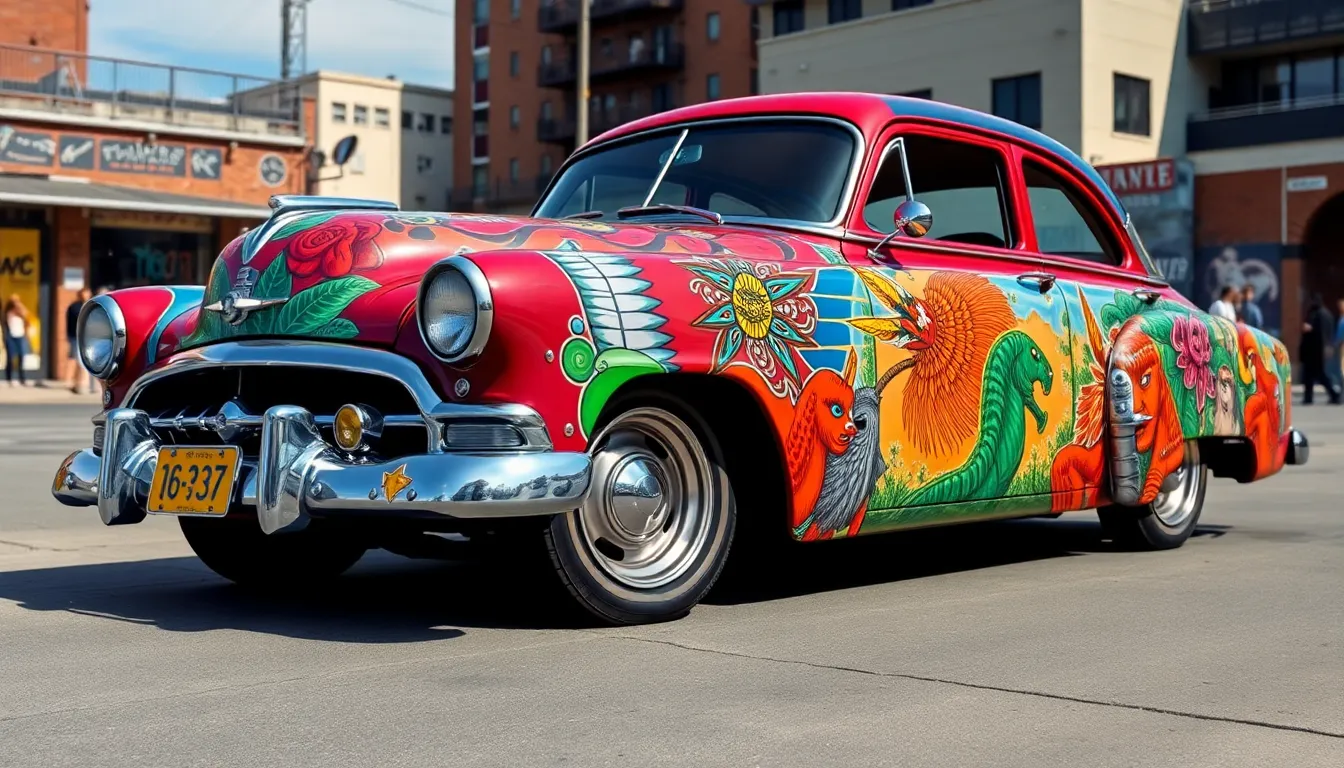
Paint transforms lowrider automobiles into rolling masterpieces that showcase cultural heritage and artistic excellence. We’ll explore the vibrant industry of custom artwork that makes each vehicle a unique expression of its owner’s identity.
Traditional Chicano Art Themes
Chicano art themes dominate lowrider paint schemes with bold imagery celebrating Mexican American culture and heritage. Aztec warriors appear frequently on hoods and side panels, displaying intricate headdresses and ceremonial armor that connects modern lowriders to ancient civilizations. Lowrider girls, known as “rucas,” grace many vehicles with pin up style artwork featuring beautiful Latinas in traditional dress or contemporary fashion.
Revolutionary figures like Emiliano Zapata and Pancho Villa command respect on trunk lids and quarter panels, their iconic mustaches and determined expressions inspiring pride in Mexican history. Brown Pride themes celebrate Chicano identity through powerful imagery of eagles, pyramids, and indigenous symbols that honor ancestral roots.
Portrait work showcases family members, fallen friends, and cultural icons with photorealistic detail that requires exceptional artistic skill. Artists spend 40 to 80 hours creating these memorial pieces that serve as moving tributes to loved ones and community heroes.
Airbrushing Techniques and Color Schemes
Airbrushing creates the smooth gradients and intricate details that define professional lowrider paint jobs. Base coats establish the foundation using deep metallics like candy apple red, royal blue, or emerald green that shimmer under sunlight and streetlights.
Multiple candy coat layers build depth and richness, with some paint jobs featuring up to 15 separate color applications. Artists use stencils and freehand techniques to create precise line work, shading effects, and dimensional artwork that appears to float above the vehicle’s surface.
Color combinations follow exact cultural preferences, with purple and gold representing royalty, while red, white, and green honor Mexican flag colors. Silver leaf accents highlight important design elements, and pearl additives create color shifting effects that change appearance from different viewing angles.
Blending techniques require years of practice to master, as artists must seamlessly transition between colors without visible brush marks or spray patterns. Professional painters invest $5,000 to $15,000 in airbrush equipment, compressors, and paint materials to achieve show quality results.
Religious and Cultural Imagery
Religious imagery holds sacred meaning in lowrider culture, with Virgin of Guadalupe representations appearing on countless vehicles as symbols of protection and faith. Artists render Our Lady of Guadalupe with incredible detail, incorporating traditional roses, angels, and radiant light effects that demonstrate both artistic skill and spiritual devotion.
Catholic saints like San Judas and Santa Muerte provide spiritual guidance and protection for lowrider owners who face daily challenges in urban environments. These religious portraits often occupy prominent positions on hoods or rear windows where they’re clearly visible to observers and fellow believers.
Cultural symbols blend seamlessly with religious themes, creating artwork that celebrates both faith and heritage. Día de los Muertos imagery transforms vehicles into mobile altars featuring sugar skulls, marigolds, and deceased family members rendered in vibrant colors that honor life and death traditions.
Crosses, rosaries, and praying hands appear as supporting elements in larger compositions, reinforcing the spiritual foundation of lowrider culture. Many owners commission blessing ceremonies for newly painted vehicles, recognizing the sacred nature of artwork that represents their deepest beliefs and cultural connections.
Low Riders Cars Clubs and Community Culture
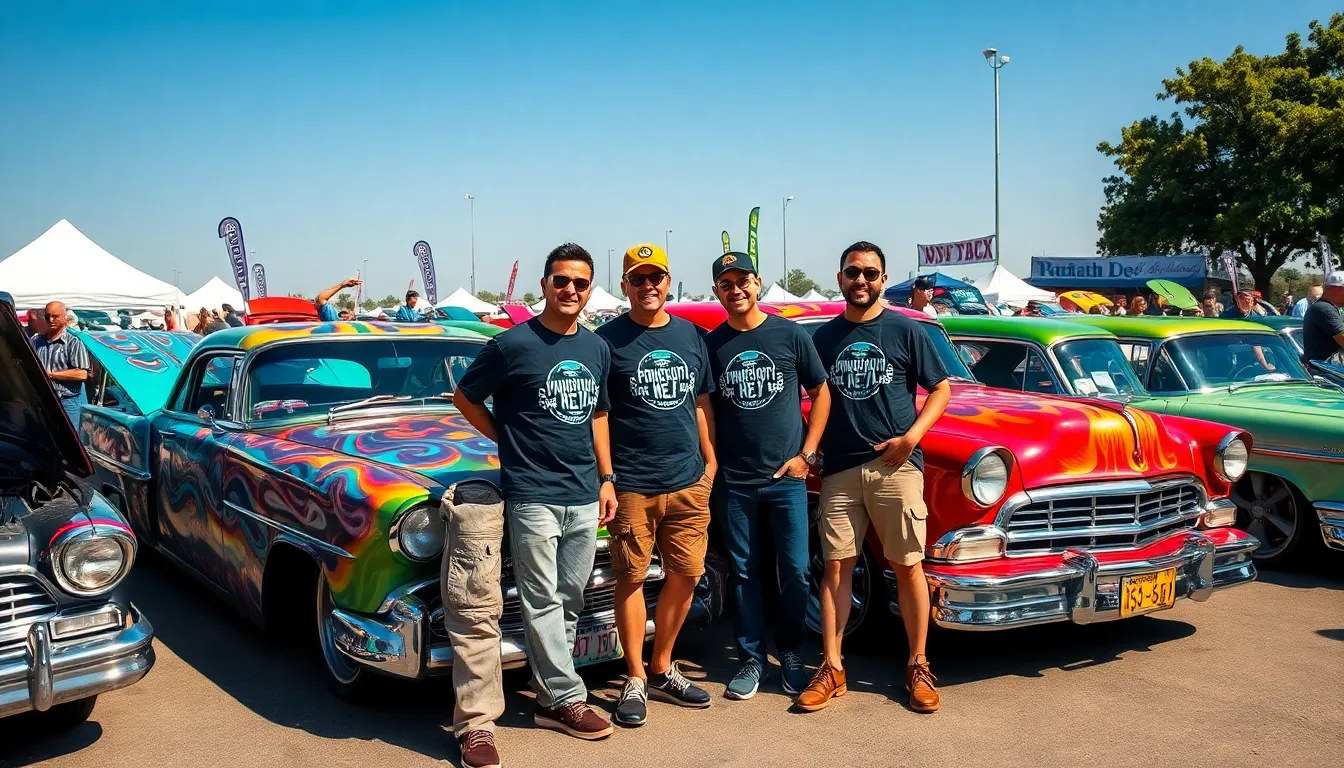
The lowrider movement thrives through organized clubs and deep community bonds that extend far beyond automotive modifications. These connections form the backbone of a culture that values loyalty, craftsmanship, and shared heritage.
Formation of Car Clubs and Brotherhood
Car clubs serve as the foundation of lowrider culture, establishing networks of friendship and mutual support throughout communities. Members unite around shared values of respect, dedication, and artistic excellence while maintaining strict codes of conduct. Brotherhood extends beyond weekend gatherings as club members support each other through life’s challenges and celebrate personal achievements together.
Establishing a lowrider club requires commitment from founding members who share similar visions for their vehicles and community involvement. Presidents lead weekly meetings where members discuss upcoming events, plan charity drives, and coordinate group cruises through neighborhood streets. Prospective members undergo evaluation periods lasting several months to demonstrate their dedication to the club’s values and lowrider lifestyle.
Club names reflect cultural pride and regional identity, with groups like Majestics, Individuals, and Groupe naming themselves after concepts that represent their collective spirit. Membership fees fund club activities, matching t-shirts, and plaques that display the club’s emblem on each member’s vehicle. Territorial respect prevents conflicts between clubs as each group maintains exact cruising routes and meeting locations throughout their cities.
Car Shows and Competition Events
Competition events showcase the pinnacle of lowrider artistry and hydraulic engineering through structured judging categories. Hop competitions test hydraulic systems as vehicles compete to achieve the highest vertical lifts, with measurements reaching over 60 inches for championship level cars. Judging panels evaluate paint quality, interior craftsmanship, engine modifications, and overall presentation using detailed scoring systems.
Super Show events draw thousands of participants from across the nation, featuring vendor booths, live music performances, and awards ceremonies that celebrate exceptional vehicles. Categories include Best Paint, Best Interior, Best Engine, and Best of Show, with trophies becoming treasured symbols of recognition within the community. Entry fees typically range from $50 to $200 depending on the event’s prestige and prize offerings.
Regional shows occur monthly throughout lowrider strongholds like Los Angeles, San Antonio, and Phoenix, providing regular opportunities for enthusiasts to display their work. Spectators pay admission fees to witness hydraulic demonstrations, browse custom vehicles, and purchase lowrider merchandise from participating vendors. Photography contests encourage attendees to capture the artistry of displayed vehicles, with winning images featured in lowrider magazines and social media platforms.
Family Traditions Passed Down Through Generations
Fathers introduce their children to lowrider culture through hands-on mechanical lessons and weekend garage sessions that teach patience and attention to detail. Sons and daughters learn welding techniques, hydraulic maintenance, and painting fundamentals alongside family members who’ve spent decades perfecting their create. Knowledge transfers through informal apprenticeships as younger generations absorb skills while assisting with vehicle restorations.
Multi-generational families often maintain matching lowriders that reflect their shared aesthetic preferences and cultural values. Grandparents pass down classic vehicles like 1964 Impalas to grandchildren who continue modifying them with modern hydraulic systems and contemporary paint designs. Family car clubs emerge when multiple relatives join the same organization, creating dynasties that influence local lowrider scenes for decades.
Cultural storytelling occurs during family gatherings where elders share memories of early lowrider pioneers and the social challenges they overcame. Children hear accounts of police harassment, discriminatory laws, and community solidarity that shaped the movement’s rebellious spirit and cultural pride. Wedding celebrations and quinceañeras feature lowrider processions as families incorporate their automotive passion into major life events and religious ceremonies.
Building Your First Low Riders Cars Project

Building your first lowrider requires careful planning and smart choices that’ll set the foundation for years of enjoyment. We’ll guide you through the essential steps to transform your dream into reality.
Choosing the Right Base Vehicle
Start with classic American cars from the 1960s through 1980s for the most authentic lowrider experience. The 1964 Chevrolet Impala remains the gold standard, offering exceptional modification potential and strong aftermarket support. Cadillac DeVille and Fleetwood models provide luxury appeal but require larger budgets for proper execution.
Consider Ford LTD and Mercury Grand Marquis models as excellent affordable alternatives for first-time builders. These vehicles feature sturdy frames that handle hydraulic stress well and offer ample trunk space for battery installations. Lincoln Town Cars from the 1990s also provide reliable platforms with comfortable interiors ready for customization.
Inspect the frame and body condition thoroughly before purchasing any base vehicle. Rust damage and structural weakness can cost thousands in repairs before modifications even begin. Look for cars with solid floors, intact frame rails, and minimal body panel corrosion that could compromise hydraulic mounting points.
Avoid vehicles with important mechanical problems unless you have extensive automotive repair experience. Focus on cars with running engines and functioning transmissions to keep initial costs manageable. A reliable drivetrain allows you to concentrate resources on hydraulics, paint, and interior work.
Budget Planning for Modifications
Expect to invest $15,000 to $25,000 for a quality first-time lowrider build with professional installation. Basic hydraulic systems start around $3,000 for single-pump setups, while advanced four-pump configurations can exceed $8,000. Custom paint jobs range from $5,000 to $15,000 depending on complexity and artist reputation.
| Modification Category | Budget Range | Key Components |
|---|---|---|
| Basic Hydraulics | $3,000-$5,000 | Single pump, 6-8 batteries, basic switches |
| Advanced Hydraulics | $6,000-$10,000 | Multiple pumps, 12+ batteries, competition setup |
| Custom Paint | $5,000-$15,000 | Base color, murals, clear coat, labor |
| Interior Work | $2,000-$8,000 | Upholstery, sound system, custom touches |
| Wheels & Tires | $2,000-$4,000 | Wire wheels, whitewall tires, accessories |
Plan for unexpected expenses that commonly arise during builds, adding 20-30% to your initial budget. Hidden rust, electrical issues, and compatibility problems can quickly escalate costs. Starting with a higher-quality base vehicle often saves money in the long run.
Consider phased building approaches to spread costs over time while enjoying your lowrider at each stage. Install basic hydraulics first, then add advanced features like multiple pumps or competition setups later. This strategy lets you learn the culture while managing financial commitments responsibly.
Finding Reputable Shops and Mechanics
Research lowrider-exact shops in your area through online forums, car shows, and local club recommendations. General automotive shops rarely understand hydraulic systems or proper installation techniques. Experienced lowrider mechanics know frame reinforcement requirements and electrical system complexities that ensure safe, reliable operation.
Visit potential shops personally to inspect their previous work and meet the technicians who’ll handle your project. Look for clean facilities with organized tool areas and examples of completed builds on display. Ask about warranty policies, timeline estimates, and their experience with your exact vehicle model.
Request references from recent customers and contact them about their experiences with quality, timing, and customer service. Reputable shops gladly provide contact information for satisfied clients. Social media pages and Google reviews also reveal consistent patterns in shop performance and reliability.
Establish clear agreements about parts sourcing, labor rates, and project timelines before beginning any work. Document all agreements in writing and require regular progress updates with photos. Quality shops welcome transparent communication and detailed project documentation throughout the building process.
Network within local lowrider communities to discover trusted mechanics who may work independently or offer specialized services. Car club members often recommend reliable technicians who understand cultural significance alongside technical requirements. These connections frequently lead to better pricing and more personalized attention to your build.
Legal Considerations for Low Riders Cars Owners
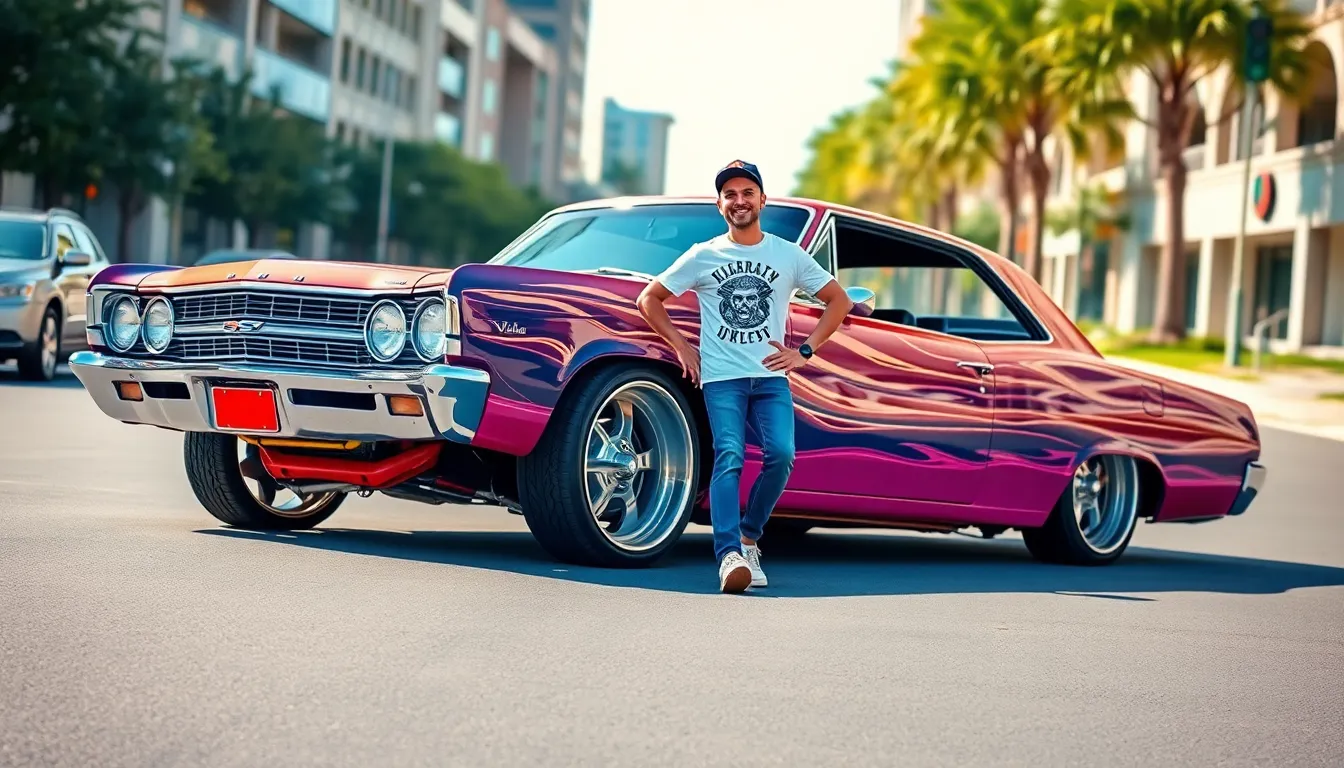
Handling legal requirements becomes crucial when owning a lowrider car across different states. Understanding regulations helps us avoid costly violations and ensures our lowrider builds remain street legal.
Height Regulations by State
Minimum height laws vary significantly across different states, creating challenges for lowrider owners traveling between jurisdictions. California requires a minimum ground clearance of 3 inches from the lowest point of the vehicle frame, while Arizona mandates 4 inches. Texas sets its minimum at 2 inches, making it one of the most lenient states for lowrider enthusiasts.
Florida enforces strict height requirements at 4.5 inches, often forcing lowrider owners to raise their vehicles significantly when moving to the state. Nevada maintains a 3-inch minimum similar to California, which benefits lowrider communities in Las Vegas. New Mexico requires 2.5 inches, reflecting its strong Hispanic cultural heritage and acceptance of lowrider culture.
Adjustable suspension systems provide the best solution for multi-state travel, allowing owners to modify ride height as needed. We recommend installing air ride systems or hydraulic setups with preset height controls to comply with varying state requirements. Smart lowrider owners carry documentation showing their vehicles can meet different state minimums when questioned by law enforcement.
| State | Minimum Height Requirement | Enforcement Level |
|---|---|---|
| California | 3 inches | Moderate |
| Texas | 2 inches | Low |
| Florida | 4.5 inches | High |
| Arizona | 4 inches | Moderate |
| Nevada | 3 inches | Low |
| New Mexico | 2.5 inches | Low |
Safety Requirements and Inspections
Annual vehicle inspections in states like Texas and Pennsylvania require lowriders to pass comprehensive safety checks including suspension components. Hydraulic systems must demonstrate proper functionality without leaking fluid or showing signs of structural weakness. Brake lines and steering components receive extra scrutiny during inspections due to modification concerns.
Lighting requirements become more complex with lowrider modifications, as headlight and taillight heights must remain within DOT specifications. We’ve found that vehicles sitting too low often fail inspection due to improper light positioning relative to ground level. Reflectors and turn signals also require proper visibility angles that lowered vehicles sometimes cannot achieve.
Frame modifications undergo strict inspection protocols, with welding work requiring professional certification in many jurisdictions. Structural integrity assessments ensure that lowrider modifications don’t compromise crash safety or handling characteristics. Documentation of professional installation helps pass inspections more easily than DIY modifications.
Exhaust system compliance presents challenges for lowriders with custom ground effects and altered ride heights. Catalytic converters must remain functional and properly positioned, while exhaust tips cannot extend below frame rails in most states. Sound level restrictions also apply, limiting exhaust modifications that exceed decibel limits.
Insurance Coverage for Modified Vehicles
Specialty insurance companies like Hagerty and American Collectors Insurance offer agreed value policies specifically designed for modified lowrider vehicles. Standard auto insurance often excludes coverage for custom modifications, leaving owners financially vulnerable after accidents or theft. We recommend documenting all modifications with professional appraisals and detailed photography for insurance purposes.
Modification disclosure requirements mandate that owners inform insurance companies about hydraulic systems, custom paint work, and performance upgrades. Failure to disclose modifications can void coverage entirely, leaving owners responsible for total loss situations. Progressive and State Farm offer modified vehicle endorsements that provide partial coverage for custom work.
Liability considerations increase with lowrider ownership due to unique risks associated with hydraulic systems and altered vehicle dynamics. Insurance companies may require higher liability limits for vehicles with competition grade hydraulic setups. Some insurers exclude coverage during car show events or organized lowrider gatherings.
Storage and security requirements often mandate enclosed storage for high value lowrider builds to maintain full coverage. Anti theft devices like kill switches, GPS trackers, and alarm systems may reduce premiums while providing additional protection. We suggest working with insurance agents who understand lowrider culture and can recommend appropriate coverage levels based on vehicle value and usage patterns.
Famous Low Riders Cars in Movies and Music
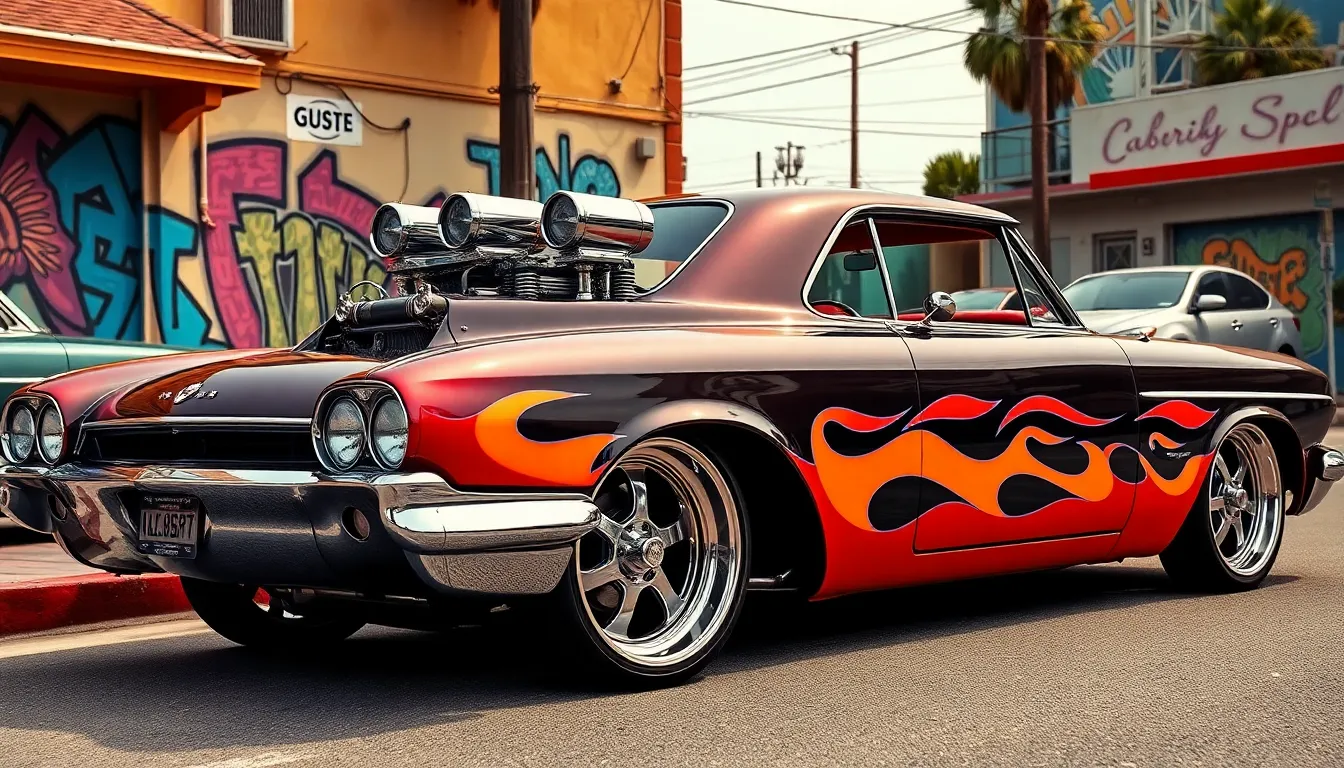
Lowrider cars transcended their cultural origins to become iconic symbols in entertainment media. We’ve witnessed these rolling works of art capture mainstream attention through memorable appearances across various platforms.
Appearances in Hip-Hop Music Videos
Eazy-E’s “Boyz-n-the-Hood” showcased authentic lowrider culture to mainstream audiences in 1988. This groundbreaking music video featured multiple Chevrolet Impalas performing hydraulic demonstrations that introduced millions to lowrider artistry.
Dr. Dre’s “Nuthin’ but a ‘G’ Thang” elevated lowrider prominence with its 1992 release featuring pristine examples bouncing through Compton streets. The video displayed immaculate paint jobs and precise hydraulic choreography that became template standards for future hip-hop productions.
Snoop Dogg’s extensive catalog includes countless lowrider appearances spanning three decades of music videos. His personal collection influences visual storytelling while celebrating West Coast automotive culture through authentic representation.
Ice Cube’s “It Was a Good Day” immortalized the 1964 Chevrolet Impala as the ultimate cruising vehicle. This video established the connection between lowriders and laid-back California lifestyle that continues influencing popular culture.
Cypress Hill’s “How I Could Just Kill a Man” featured lowriders as symbols of Chicano pride and street credibility. Their music videos consistently showcase hydraulic demonstrations while honoring the culture’s Mexican American roots.
Hollywood Films Featuring Low Riders
“American Me” (1992) provided authentic representation of Chicano lowrider culture through Edward James Olmos’s direction. The film featured genuine car club members and their vehicles creating realistic portrayals of East Los Angeles automotive traditions.
“Mi Vida Loca” (1993) showcased female participation in lowrider culture through Latina protagonists and their customized rides. Director Allison Anders captured the intersection of gang life and car culture with remarkable accuracy.
“Blood In Blood Out” (1993) displayed extensive lowrider scenes throughout its three-hour runtime depicting generational car culture connections. The film’s automotive sequences featured authentic hydraulic competitions and car show atmospheres.
“Training Day” (2001) included memorable lowrider scenes during Denzel Washington’s character development through Los Angeles neighborhoods. These appearances reinforced lowriders as integral components of urban West Coast identity.
“Fast and Furious” franchise incorporated lowriders into street racing culture beginning with early installments. The series introduced global audiences to hydraulic systems while connecting various automotive subcultures.
Celebrity Owners and Their Custom Rides
George Lopez owns multiple award-winning lowriders including a 1958 Chevrolet Impala featuring intricate airbrushed murals. His collection represents successful integration of entertainment career success with cultural heritage preservation.
Paul Rodriguez maintains an impressive stable of customized vehicles showcasing professional-grade paint work and competition-level hydraulics. The comedian’s passion extends to active participation in car shows and lowrider community events.
Cheech Marin collected lowriders throughout his entertainment career while advocating for Chicano art recognition. His vehicles feature museum-quality craftsmanship reflecting his commitment to cultural preservation.
Jesse James built custom lowriders during his West Coast Choppers era combining traditional techniques with modern engineering. His creations pushed artistic boundaries while respecting lowrider tradition fundamentals.
Danny Trejo owns several classic lowriders that appear regularly at Los Angeles car shows and community gatherings. The actor’s vehicles showcase traditional Chicano imagery while supporting local automotive artisans.
Kobe Bryant owned a customized 1967 Chevrolet Impala featuring Lakers-themed paint schemes and premium sound systems. His appreciation for lowrider culture connected basketball success with Los Angeles automotive heritage.
Maintenance and Care for Low Riders Cars

Proper maintenance keeps your lowrider performing at its best while preserving the investment you’ve made in custom modifications. Regular care ensures your hydraulic systems function smoothly and your artistic paint work remains vibrant for years to come.
Hydraulic System Upkeep
Hydraulic fluid changes should occur every 6 months or 3,000 miles to prevent contamination and maintain optimal performance. Check fluid levels weekly since even small leaks can lead to pump damage and costly repairs. Inspect all hydraulic lines for cracks, wear, or loose fittings that could cause sudden system failures during operation.
Battery maintenance requires monthly cleaning of terminals and checking water levels in non-sealed batteries. Deep cycle marine batteries typically last 3-4 years with proper care and regular charging cycles. Replace corroded wiring immediately since electrical problems can damage expensive hydraulic components.
Pump seals need inspection every 3 months for signs of wear or leakage around the motor housing. Lubricate all moving parts according to manufacturer specifications to prevent premature wear. Keep spare fuses and relays in your vehicle since electrical components can fail without warning.
Protecting Custom Paint Work
Daily washing prevents dirt and contaminants from etching into your custom paint layers. Use pH neutral car soap and microfiber towels to avoid scratching delicate airbrush work and murals. Park in covered areas whenever possible since UV rays fade even the highest quality automotive paints over time.
Waxing every 2-3 months with high quality carnauba wax protects your investment and maintains the deep shine that makes lowriders stand out. Apply ceramic coatings for long term protection against environmental hazards like bird droppings and tree sap. Touch up small chips immediately using matching paint from your original artist to prevent rust formation.
Professional detailing every 6 months keeps intricate murals and custom graphics looking fresh and vibrant. Avoid automated car washes since the harsh brushes can damage delicate paint work and custom accessories. Store touch up paint in climate controlled environments to maintain color matching accuracy.
Storing Your Low Rider Properly
Climate controlled garages protect your lowrider from temperature fluctuations that can damage hydraulic seals and paint finishes. Maintain humidity levels between 40-50% to prevent rust formation while avoiding excessive dryness that cracks leather interiors. Use breathable car covers made from cotton or specialized fabrics that won’t trap moisture against your paint.
Battery maintenance during storage requires disconnecting terminals and using trickle chargers to maintain proper voltage levels. Hydraulic systems should be exercised monthly by running all functions through their full range of motion. Change engine oil before long term storage since used oil contains contaminants that can damage internal components.
Tire care involves inflating to proper pressures and moving the vehicle periodically to prevent flat spots on expensive whitewall tires. Place the car on jack stands if storing for more than 3 months to remove weight from suspension components. Document your storage procedures with photos and maintenance logs to track the condition of all systems over time.
Conclusion
Lowrider culture continues to thrive as one of America’s most distinctive automotive movements. We’ve witnessed how these rolling masterpieces blend mechanical innovation with artistic expression while preserving deep cultural traditions.
The lowrider community proves that cars can be more than transportation—they’re canvases for creativity and symbols of identity. From hydraulic engineering to hand-painted murals each element tells a story of craftsmanship and cultural pride.
Whether you’re drawn to the technical aspects or the artistic heritage lowriders offer something unique in today’s automotive industry. We encourage enthusiasts to respect the culture’s roots while embracing the innovation that keeps this tradition rolling forward into the future.
Frequently Asked Questions
What is a lowrider car?
A lowrider is a modified vehicle featuring hydraulic suspension systems that allow it to raise and lower its height, often dramatically. These cars originated from Chicano communities in 1940s California and are characterized by custom paint jobs, wire wheels, and artistic interiors. They represent cultural pride and artistic expression within Mexican American communities.
How much does it cost to build a lowrider?
Building a lowrider typically costs between $15,000 to $25,000 for modifications, not including the car purchase price. Costs vary based on hydraulic complexity, custom paint work, interior modifications, and wheels. Basic single-pump hydraulic systems are more affordable, while competition-grade multi-pump setups require significantly higher investment.
What cars are best for lowrider builds?
The 1964 Chevrolet Impala is considered the gold standard for lowriders due to its sleek design and modification potential. Other popular choices include Cadillac DeVille, Fleetwood models, Ford LTD, and Mercury Grand Marquis. Classic American cars from the 1960s to 1980s typically offer the best foundation for lowrider builds.
Are lowriders legal to drive on the street?
Yes, lowriders can be street legal if they meet state height regulations and safety requirements. Each state has different minimum height requirements, ranging from 22 to 27 inches from ground to frame. Owners must ensure proper lighting, structural integrity, and may need adjustable suspension systems for multi-state travel.
How do lowrider hydraulic systems work?
Lowrider hydraulic systems use electric pumps to move hydraulic fluid through cylinders, raising and lowering the vehicle. Basic single-pump setups provide simple lift functions, while advanced multi-pump configurations enable complex dancing movements. These systems require multiple batteries and specialized electrical components to operate effectively.
What is the cultural significance of lowrider cars?
Lowriders represent Mexican American cultural identity, pride, and artistic expression. They emerged as symbols of resistance against discrimination and evolved into mobile canvases showcasing Chicano art, religious imagery, and family heritage. The culture emphasizes community, craftsmanship, and passing traditions through generations via car clubs.
Do I need special insurance for a lowrider?
Yes, lowriders typically require specialty insurance policies that cover custom modifications. Standard auto insurance may not adequately protect hydraulic systems, custom paint, and interior work. Owners must disclose all modifications to insurance companies and work with agents experienced in modified vehicle coverage.
How often do lowriders need maintenance?
Lowriders require regular maintenance beyond standard car care. Hydraulic systems need fluid changes, pump inspections, and battery maintenance. Custom paint requires professional detailing and protective waxing. Battery banks should be checked monthly, and hydraulic seals inspected regularly to prevent costly repairs and maintain optimal performance.

